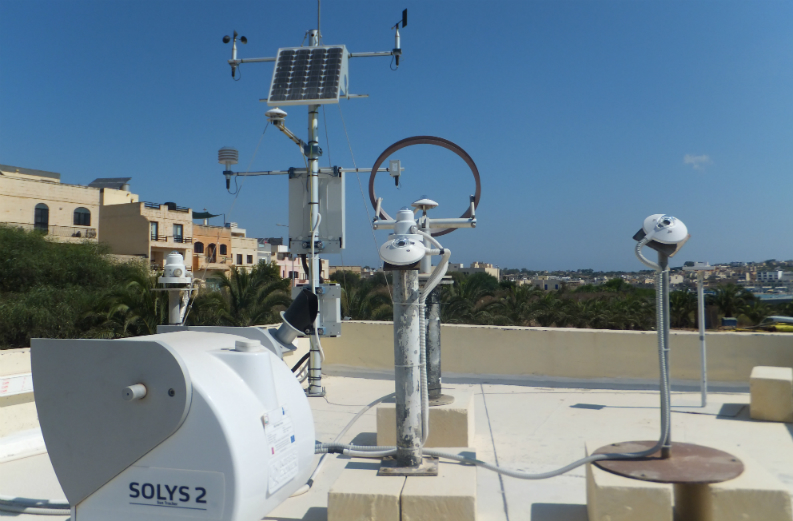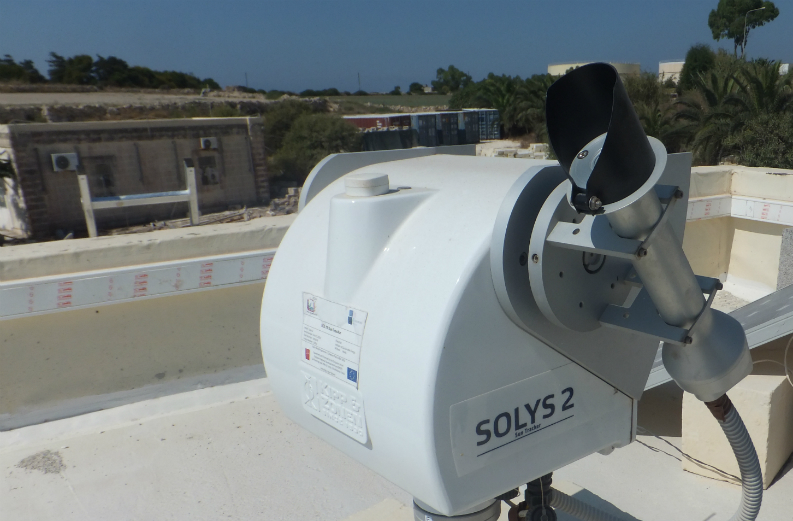Eur Ing. Dr. Charles Yousif started a data monitoring campaign that has since grown to encompass more instruments from Kipp & Zonen. Besides monitoring global and diffuse solar radiation (with a shadow ring) on the horizontal, the Institute has also acquired through University of Malta research funds, pyranometers for measuring inclined solar radiation (36° being the latitude of Malta and 45° being the optimum angle for thermal solar energy applications).
More recently, two radiometers have also been added to monitor the UVA, UVB and Erythermal (UVE) radiation on site. A pyrheliometer was finally added together with a SOLYS2 GPS tracking system, thanks to co-financing from the Renewable Energy Scenarios in Islands (R.E.S.I.) project of the Italia-Malta 2007-2013 cross-border funds of the EU.
For many years, the Institute has been the only entity in Malta that monitors global solar radiation on a long-term basis. It is now the only place where actual data on UV radiation and direct normal radiation are being collected.
 The complete solar and meteorological monitoring station on the roof of the Institute for Sustainable Energy
The complete solar and meteorological monitoring station on the roof of the Institute for Sustainable Energy
From our experience, the performance of the Kipp & Zonen pyranometers has always been satisfactory. In the early years, the instruments had continued working, even when the strong solar radiation of Malta had managed to deteriorate the protective cable sheathing. Nowadays, we pass all cables through flexible conduits to avoid such deterioration, although this is not necessary with the current yellow cable.
The collected data has been used for a plethora of purposes including general solar and UV radiation monitoring studies, as well as specific applications for building design and the effect of UV radiation on health. More recently, the data has been used in the weather file for Malta in the national energy performance rating software for non-dwellings (iSBEM-mt).
Re-calibration of instruments is of utmost importance for a quality database collection. Our experience with the services department of Kipp and Zonen was positive. Our intention is to complement our newly acquired weather station (co-financed by the European Regional Development Fund, ERDF, under Operational Programme 1, 2007-2013 – Priority Axis 4 Project Ref. No. 335) with solar energy data, to be able to offer a one-stop shop for weather data on the Island of Malta.
Our project will focus on preparing a typical meteorological year (TMY) for Malta, which is still lacking. It has been consistently noted that existing international software that requires weather databases often uses simulated data or data from nearby stations to represent the weather file for Malta. In many cases, this approach is not sufficiently accurate because the climate is peculiar to the Island and is not similar to nearby stations from the Island of Sicily (Italy), or nearby countries such as the coastal regions of Libya or Tunisia.
Find out more about the Institute for Sustainable Energy at www.um.edu.mt/ise
 The SOLYS2 with CHP1 pyrheliometer on the roof of the Institute for Sustainable Energy
The SOLYS2 with CHP1 pyrheliometer on the roof of the Institute for Sustainable Energy
By Eur Ing. Dr. Charles Yousif, Institute for Sustainable Energy, University of Malta